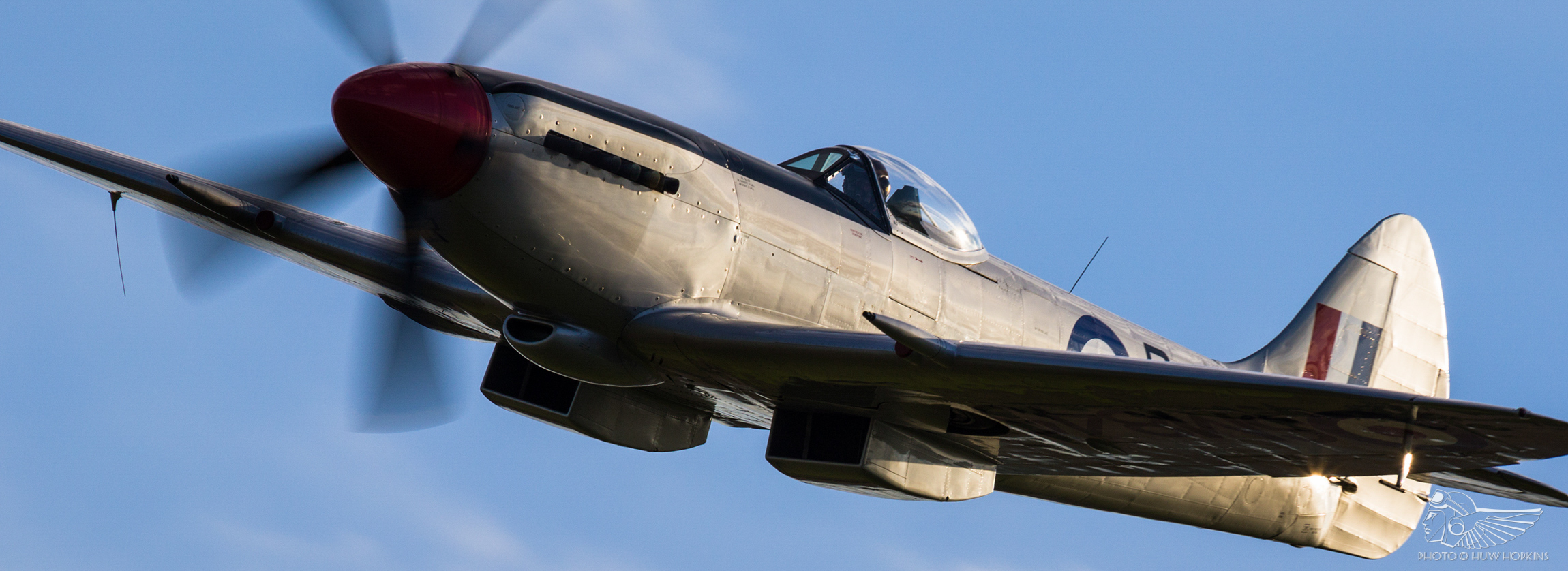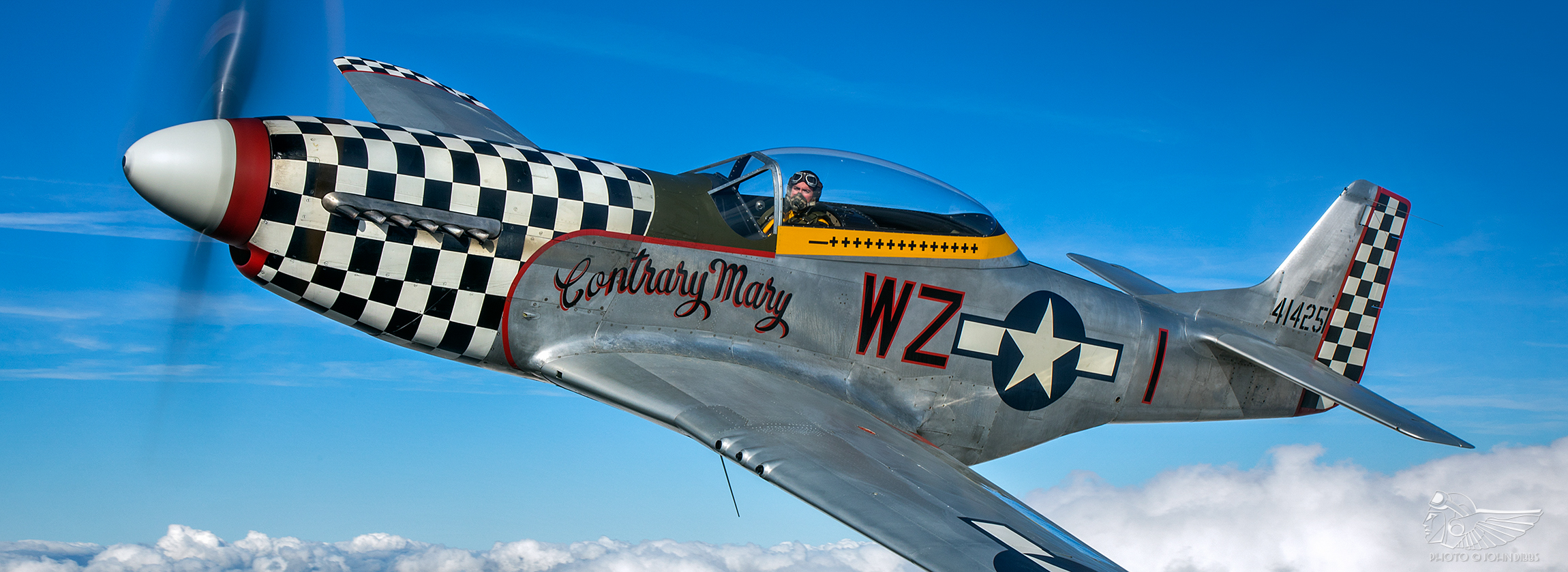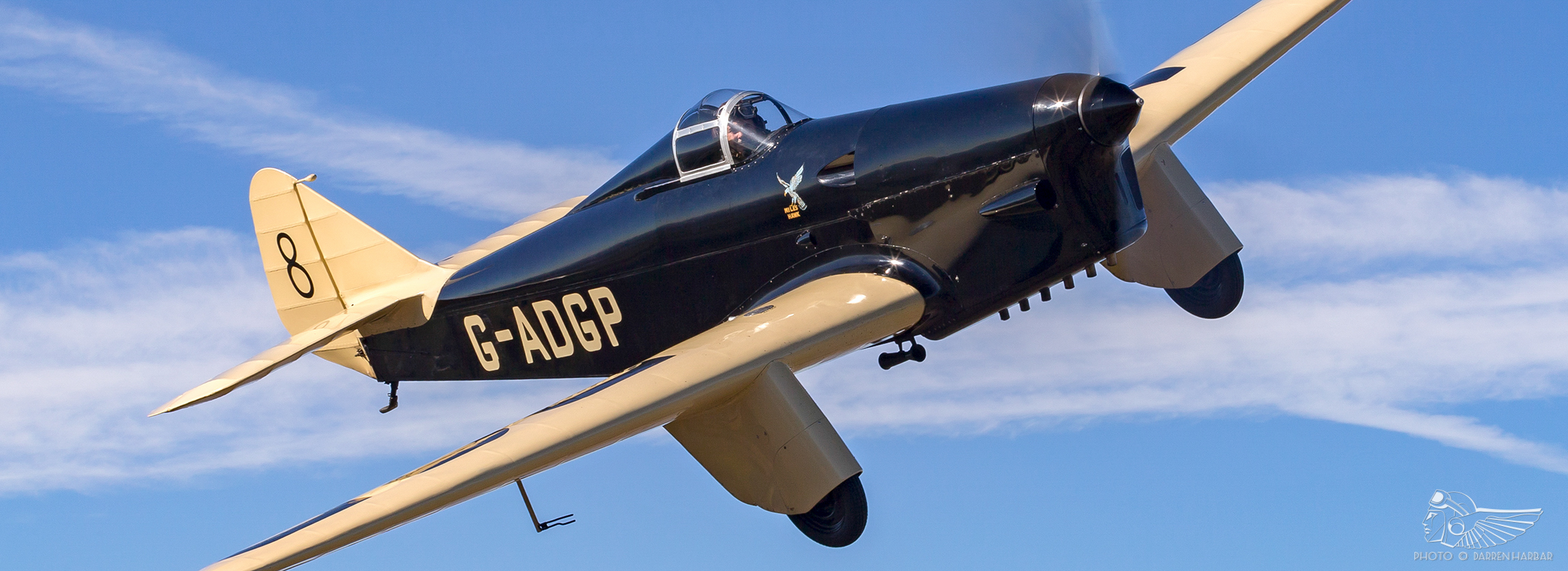“I’m more and more in love with it every time I fly it,” Eskil Amdal enthuses through a smile, shaking his head. “It has all the character of a piston fighter, with the performance of an early jet. That was remarkable to me!” The aeroplane in question is two-seat Hawker Sea Fury T.20 ‘WG655’, the Duxford-based silver and yellow ultimate big piston he has been flying with increasing frequency since 2018, and his near two-hour glowing assessment of its handling characteristics and performance reflects a clear adoration of the type.
A career fast-jet pilot with a penchant for Harley-Davidson motorbikes, it’s not hard to see why Eskil is described by one of his colleagues as ‘the real-life Top Gun’. Yet in-person the man is coolly disarming, with no discernible ego and a relaxed, easy demeanour. Aviation has been his passion for decades; it’s taken him around the world, allowing him to amass more than 3,600 hours at the time of writing on myriad types from Tiger Moth to F-35 Lightning II, through classics like the Spitfire, Mustang, Dakota and Starfighter.
As a child he built and flew model aeroplanes, that early interest burgeoning as he joined the Royal Norwegian Air Force (RNoAF) in 1992, going solo on the high-wing SAAB Safari in February 1994. He went on to fly F-16 Fighting Falcons with 331, 332 and 338 Squadrons RNoAF, underwent an exchange tour with XI(F) Squadron at RAF Leeming on the Tornado F3, and completed combat deployments in Kosovo and Afghanistan. Flight testing the F-35 Lightning II for the RNoAF took him to the USA to spearhead that aircraft’s introduction to military service. Most recently, he was responsible for overseeing Norway’s F-16 and F-35 operations.
Eskil’s career as a test pilot has also branched out into the civilian world – he led the test programme on the Friends of the Norwegian Starfighter Association’s CF-104D Starfighter and, at the opposite end of the spectrum, has flight tested the fascinating hybrid Equator P2 prototype. The breadth and depth of knowledge and experience as a military and civilian test pilot gives him a unique vantage point from which to assess a late-piston fighter of the Sea Fury’s calibre.
Involvement with warbirds came in the most unlikely of ways in 2007. A year at the US Naval Test Pilot’s School, NAS Patuxent River, Maryland, culminated with a particularly exciting assessment. Eskil lobbied to base his final practical project around the P-51 Mustang, the dissertation evaluating the aircraft’s suitability as a domestic counter-insurgency aircraft. The concept was that the US Navy would utilise surplus Mustang airframes from South America to engage border-running cartels; Eskil and his colleague had eight days to vigorously test the concept, putting Mustangs loaned from Lee Lauderback’s Stallion 51 facility through formation aerobatics, high-performance handling, simulated low-level strafing on a military range, timed “from cold” Quick Reaction Alert scrambles, and unprepared airstrip operations. At the end of the test schedule they delivered a 200-page feasibility study – “extremely hard work”, he says, “but a joy to be able to explore the Mustang in such depth. There are flying qualities in warbirds and vintage aircraft that any fixed-wing pilot should be aware of, and those qualities will help hone their skills as aviators.”
Whilst flying F-16s in the early part of the decade, Eskil enjoyed exposure to numerous vintage types such as Tiger Moth, Chipmunk, Cornell and Harvard. “Both military and civilian operations coexisted on the same base,” he recalls, “and I would fly F-16s until 3.30pm – very sociable working hours in Norway – then walk across to the other side of the air base and continue my day flying historic tail draggers”. In time, he flew P-51D Mustang Old Crow – now ‘The Shark’ – and has since flown Spitfire Mk.IXs for the Boultbee Flight Academy, where he is a certified flying instructor on type. Conversion to Sea Fury T.20 ‘WG655’, stablemate of ‘The Shark’, followed in 2018.
The Sea Fury T.20 had arrived in the UK in 2009, joining The Fighter Collection’s (TFC) fleet at Duxford. Restored in the USA with a stock Bristol Centaurus Mk.18 engine and Rotol five-bladed constant-speed propeller, the Sea Fury flew with TFC for several years before protracted engine issues kept it grounded. It was sold to Shaun Patrick in 2018 and is now operated by the Norwegian Spitfire Foundation (NSF) under the care and maintenance of the Aircraft Restoration Company (ARCo) at Duxford. ‘WG655’ has been a frequent and popular participant at British airshows and is now available for high-end warbird experience flights under ARCo’s Aerial Collective (A/C) banner.
Prior to transfer to Shaun Patrick in 2018, TFC engineers removed the Centaurus engine and undertook an engine change using a conversion kit formulated by Sanders Aeronautics in the USA, replacing the stock engine with a Pratt & Whitney R-2800-CBD engine and mating it with a huge four-blade constant-speed Hamilton Standard propeller from a Grumman Guardian. Such conversions were reasonably commonplace in American Sea Furies; Larry Burton was the first to do it, installing a Wright R-3350 on air racer Blind Man’s Bluff in 1988, with Nelson Ezell developing a conversion kit for that engine. Sanders Aeronautics followed suit in 1994, mating a Wright R-3350 to Argonaut, but poor reliability saw them look to the R-2800 – the classic American radial that powered the Thunderbolt, Hellcat, Invader and Corsair, amongst others – for a viable replacement. Sanders found it to be equally as effective as the larger R-3350, and test flights throughout spring 2011 yielded positive results, the R-2800 conversion kit following in due course. Both 18-cylinder, two-row, air-cooled radials, the Centaurus and R-2800 are sufficiently similar for the American engine to offer a highly dependable replacement for the original powerplant.
Contrary to the aircraft’s vast size, the Sea Fury’s cockpit is a cramped environment for the pilot. The cockpit floor slopes upwards, aligning the rudder pedals with the pilot’s midriff and thus partially neutralising g effects – beneficial for a high-speed, high-performance transonic fighter capable of pushing 400kts. The layout also allows for reversion to the direct-action control column, rather than the wrist-action type famously seen in Spitfires and Hurricanes.
This Sea Fury’s cockpit has undergone a number of modifications from stock to accommodate the Sanders conversion. Sweeping from the left, the trim wheels sit beside the pilot whilst the throttle, propeller, fuel cut-off and mixture levers sit in a large quadrant with the undercarriage lever positioned in an open box directly below. The throttle lever is huge – around twice the height of a Mustang’s, with a lengthy travel of approximately one foot from idle to take-off power. Propeller rpm and mixture control in stock Sea Furies are automatic (with a propeller override to a maximum of 2,800 rpm), governed by setting the throttle lever. ‘WG655’ differs in that both are controlled by individual levers, separate to the throttle control, as is typical for American radials. “That does offer a mental challenge,” says Eskil, “as the Mustang’s mixture lever is hinged for you to push the lever down and forward to go from Idle Cut-off to Rich. In the Sea Fury, it’s the opposite – you’re pulling the lever towards you and up to do that. It does require focus, particularly if you’re flying both aeroplanes on the same day. If you’re coming back to base and you want to go from Auto-lean to Rich in the downwind to land and you get it the wrong way round, it gets quiet very quickly and you have the chance to demonstrate your superb reflexes!”
A précis of the instruments identifies six core dials in the traditional blind flying panel (airspeed indicator, artificial horizon, altimeter, turn and slip indicator, compass and vertical speed indicator), with modern radio and GPS units installed above. Engine instruments are clustered discretely to the right, with fuel flow indicator, manifold pressure gauge, tachometer and various temperature and pressure gauges most prominently placed. Engine starting controls, including the primer and ignition push buttons, sit on a horizontal panel on the starboard side of the cockpit, along with other controls such as drop tank release, fuel gauges and an array of switches for numerous systems. The emergency gear and flap blow-down controls also sit beside the pilot’s right thigh (though the latter is disabled on ‘WG655’).
As is customary for any radial aircraft, the propeller is turned through several blades before start-up to distribute oil around the engine and avoid a hydraulic lock. In-cockpit, the fuel pump is activated and the starter engaged. After eight blades of rotation the magnetos are switched on and the electric primer engaged for three cycles of three seconds before the ignition switch is activated. When the engine runs, the mixture is advanced to auto-lean and complimented with the primer until it settles at 600-700 rpm. Power is then gently increased to the region of 1,000 rpm and left there to avoid fouling the spark plugs. “It’s a great engine to start”, says Eskil. “I love the sound of it and the visceral feeling. I used to find starting radials intimidating, but there’s something attractive about that – you want to master it. I remember one of the first times I started it up, it was parked on the hard ramp facing TFC with a westerly wind. I had the canopy open as it fired up, and there must have been a lot of oil pooled in the lower cylinders as on ignition it coated my whole helmet, face and windscreen with oil. I just looked at Martin Espin [TFC’s Chief Engineer] and shrugged! I ran it for a few minutes at 1,200 rpm to distribute the oil and get as much of it back to the 14 gallon tank as possible, then shut it down to give it a thorough clean.”
For the engine warm-up, fuel mixture is placed into Rich and, provided the minimum oil temperature of 40°C and cylinder head temperature of 120°C are reached, the throttle opened to 1,800 rpm for the magneto check. This should indicate a maximum 100 rpm drop, but ‘WG655’ rarely sees any more than a 30-40 rpm drop as the magneto switches are switched off and on in turn. The propeller is then cycled three times to run warm oil through the governor. The R-2800 can run comfortably for lengthy periods on the ground with no tendency to overheat, and the cylinder head temperature rarely threatens to reach the 260°C threshold; equally, with foot brakes actuated through the rudder pedals, protracted periods spent at the runway hold can cause the pilot discomfort.
Once lined up on the runway, the tail wheel is locked, stick brought right back into the pilot’s stomach and the brakes released to allow the Sea Fury to track forward on idle power at 20inHg (“) before the throttle is advanced to take-off power of 48” and 2,800 rpm (though some airspeed is needed to push through the last 200 rpm). “You should be linear with your movements, not abrupt, and not trying to do too many things at once”, says Eskil. “There’s a lot of rotating mass up front so you have to make small, gentle throttle adjustments – it’s a massive throttle lever, and advancing from idle to take-off power covers around three-quarters of the lever’s travel. It’ll comfortably get airborne above 45”, but you find it rotates at around 100kts before you get there. No flap required.” With a gear airspeed limit of 140kts, it’s essential to get the undercarriage up quickly. Eskil continues: “You can’t keep the gear down for a few seconds whilst keeping the nose down on take-off as it’ll rocket through that threshold. You also want to get the gear up early in case you lose the engine and need to get back down on the ground – there’s nowhere but straight ahead to go, and you don’t want that gear down if you’re going off the end of the runway. The Sea Fury also has the smallest g-margin during gear retraction I’ve ever seen; if you climb away from the runway at 1.5g when the gear is down or travelling, it won’t lock and you’ll need to cycle the gear – that’s particularly notable if you’re going around on final to land.”
Throttle and propeller are worked back to 40” and 2,400 rpm respectively in the climb to achieve 140kts, with cylinder temperatures typically sitting at around 160°C and unlikely to move too far either side of that, and the mixture returned to Auto-lean for cruise. At cruise altitude – which, for long-distance international trips to airshows on the continent, can be as high as 10,000ft – fuel consumption is the primary concern. With an automated thermostatically controlled oil cooler and radiator regulating engine temperatures in the cruise, much of the pilot’s workload is focused on fuel management. ‘WG655’ has five fixed self-sealing fuel tanks with a maximum capacity of 200 gallons – a central fuselage tank (97 gallons), nose tank (17 gallons), two interspar wing tanks (28 gallons each) and an auxiliary tank (30 gallons) along the leading edge of the starboard wing – with the main tank drawing fuel automatically from the other tanks.
“It does have one particular idiosyncrasy with its fuel system”, Eskil explains. “An amber light hidden low down in the bottom right of the cockpit is actuated when the wing tanks run dry – effectively warning you that you only have the main tank to rely on. If the caps in the wing tanks are not completely sealed, they can draw air and stop feeding even when the gauges show they’re still bearing fuel. If that happens you’re doing some quick private mathematics to make sure you have enough fuel in the main tank to get you home! The most fuel economic cruise is 35” and 2,000 rpm, with consumption of around 75 gallons an hour. At 25” and 1,800 rpm you can bring that down to 45 gallons an hour, and you’ll still be cruising at 180kts even though it feels like it’s barely chugging over!
“I do like to take an aircraft up and test its maximum performance and stall characteristics”, Eskil says. “That’s very important for warbirds – we fly them closer to their limits at airshows, low-level with a lot of airspeed, and you need to understand what they’re capable of and how you can adapt the aircraft’s individual performance characteristics to the air display profile.” Eskil has been prolific in ‘WG655’ in 2019 – trips to his native Norway were high points, whilst displays at Duxford’s Flying Legends and Battle of Britain Air Show offered memorable display experiences, including a rare opportunity to see the UK’s full contingent of airworthy Sea Furies flying together for the first time. A trip to the Paris-Villaroche Air Legend in early September, meanwhile, yielded a pair display alongside FAST Aero’s Belgium-based Iraqi Fury ISS.
The Sea Fury is, Eskil enthuses unequivocally, a stunning air display mount: “The harmonics of the controls are just wonderful, and the automatic oil cooler and absence of cowl flaps on ‘WG655’ allow you to concentrate on flying. You could just go on and on yo-yoing it into the vertical; it’s incredibly fun from an in-cockpit perspective.” With the propeller set to 2,500 rpm and throttle set at 45”, a dive-in from 4,000ft will effortlessly show 370kts on the airspeed indicator – just shy of the 382kt VNE – allowing a 5g pull up into the vertical that will hit 3,000ft at its apex, the airspeed having bled to 150kts or slower. Lessen that pull and the Sea Fury could easily top 6,000ft in the climb. At lower airspeeds and with a tighter pull, looping figures can be safely flown in just 2,500ft of vertical airspace. Eskil will trim out the Sea Fury between 250 and 300kts on his first run-in, that being the most consistent display airspeed range, otherwise he leaves the trim tabs alone and counteracts any divergence through control inputs. A quartering rudder input at the apex of the verticals, for example, should settle any torque induced yaw.
“It has tremendous momentum in the climb”, he continues. “But isn’t so slick on the pull-out due to the drag profile caused by the radial engine. It’s also interesting that when we flew the three Furies together at Duxford, we had two Centauri and the R-2800 in a tail-chase. We found that the R-2800 would out-climb the Centaurus-powered Furies, but they would be pulling away rapidly on the pull-out of vertical figures – that must be down to the differences in the propellers, and 500 more horsepower. The Sea Fury regains its energy very easily and doesn’t take much to get back to 280kts, albeit you can loop at even less than that. It’s a safe aeroplane as you’re not going to run into trouble with energy management.
“You do have to watch out for over-boosting, though” Eskil adds, “as there’s a differential of 10” during a loop, with the manifold pressure bleeding off in the vertical. If you’re too eager to overcompensate by opening the throttle or if you don’t close the throttle on the downhill, you could ruin that engine. You’re constantly making throttle adjustments to ensure your manifold pressure stays in the green and doesn’t tip over the max continuous limit, or the redline of 52”.”
Rolling figures are a delight to fly, the Hawker patent spring servo-tabs fitted to the ailerons and rudder (but not the elevator) allowing for light and effective lateral control inputs across the airspeed range. The tabs decrease lateral control forces at high airspeeds and rapid input, meaning the pilot’s stick inputs feel lighter. A torsion bar is anchored to the aileron control surface at one end and the control column linkage at the other, and the pilot’s control input is transmitted from the stick and through the spring, which twists and moves the tab to deflect the aileron surface by the requisite amount without increasing stick forces. “It rolls fantastically at 380kts, like a knife through butter,” says Eskil, “and the tabs help you achieve a roll rate of 100° per second at higher airspeeds without the stick forces feeling heavy. You need two hands to roll a Mustang at that airspeed. That design really feels ahead of its time and is similar to the irreversible hydraulically-powered flight controls found in the early fast-jets, such as the Starfighter, where you have that artificial feel from the tabs with the same stick forces on the ground as in the air.”
Slow-speed handling is described as docile, its stall characteristics reassuringly forgiving for such a potent high-performance fighter. “The Sea Fury wing talks to you like the Spitfire’s does”, he continues. “It’s much more forgiving than the Mustang wing, which just lets go in the stall and throws you on your back in a second. The stall characteristics naturally vary depending on angle-of-attack – airspeed and g – but in all configurations you’ll feel the aircraft starting to burble as it approaches the stall.” A clean 1g stall at idle power will see the Sea Fury depart to the left with a wing drop at 65kts, but control can be regained surprisingly quickly after decreasing the angle-of-attack. Stalls with gear and flaps down are a more sedate, and the aircraft will rumble and rock and then depart with a slight wing drop at around 60kts.
Accelerated stalls are a more prominent risk in the air display environment. “If you’re flying high-g aerobatics, say in a solo display or tail-chase, you need to listen to the aircraft and monitor its turn rate. It shouldn’t be mice running on the wing, and it shouldn’t be elephants, but you want to feel Jack Russells on the wing to know you’re safely in the higher end of the performance envelope”, he adds, formulating one of the best aviation analogies imaginable in the process. “If you pull too hard, the nose starts to hunt, and the turn rate will vary. You’ll feel it progressing quickly through a light burble to a heavy rumble before it departs, typically at around 200kts and 4g, with an abrupt wing drop typically to the left. When you first feel that buffet you can max perform the wing and fly through it, monitoring the turn rate to ensure you don’t get too slow with too high an angle-of-attack to depart – if you’re really slow, the wing has given up a lot of its flying capability and there’s not much else to counterbalance the gyroscopic effect of that massive propeller.”
Flight complete, the break to land sees the throttle gradually closed, the first stage of flap lowered at 170kts and another stage following at 150kts in tandem with lowering the gear and adjusting the mixture to Rich. If the oil temperature is running a little high, there’s the option of manually opening the oil cooler flap. To counteract the drag, the power is brought back up to 22-25” with the propeller kept coarse at around 2,000 rpm. The airspeed is down to 110kts as the aircraft turns final and another stage of flap introduced as the final pre-landing checks of gear, airspeed, propeller, mixture, throttle and temperatures and pressures are completed in turn. “I tend to set the propeller to full fine only on short final,” adds Eskil, “looking for 2,400 rpm to allow the propeller to be responsive enough to pull the aircraft away rapidly if I need to go around. It’s a fine line between protecting the engine and giving yourself enough margin to go around”.
The Sea Fury settles over the threshold at around 100kts. “You have to be on the ball to settle any directional divergence”, Eskil says. “If you try to three-point it or you’re a little too slow, you’re likely to feel it trying to depart. When you lower the tail, you’ll usually see a bit of a wobble as it tries to diverge. I tend to land it tail-low for that reason, as you would a Mustang, albeit I have three-pointed it on a 1,000-metre grass strip with no issues.” Post-flight, Eskil will run the engine at 1,200 rpm for a minute or so to stabilise the engine before placing mixture into Idle Cut-off and switching off the magnetos, fuel and other systems.
“The flying control system, automation and speed of the thing really timestamp the Sea Fury as a transitional aircraft between the pistons and the jets”, he reflects. “It performs very well as a high-speed fighter with tremendous handling characteristics broadly more akin to the early jets than to its contemporaries. They first flew five years apart, but both Sea Furies and Mustangs fought over Korea and the former feels like a totally different generation to the P-51. I can understand how Furies shot down MiG-15s in Korea; the MiGs couldn’t out-turn them, and if the Fury pilots could lure the MiGs in close and slow, its lower wing loading would give it a far better turning rate than the MiG’s swept profile. It’s also an interesting glimpse of how British and American designers began to standardise as the war went on – the Sea Fury certainly has an interesting mix of British and American technology and design intricacies, such as the tail wheel lock and the positioning of the undercarriage lever to the left of the pilot – both atypical for some British aircraft. My assumption is that, this being the last generation of piston fighters, the manufacturers were collaborating more and becoming more streamlined. There’s a slight parallel with the F-35 in that respect.
“As with all historic aircraft, it has its quirks that can catch you out”, Eskil muses. “As humans, we find a way to adapt and we become accustomed an aircraft’s deficiencies – it’s like getting used to driving a car with an awkward gear stick transition. With the Sea Fury, I’ve found that the more I fly it, the more I enjoy it, learn it and adapt to its idiosyncrasies, which become a pleasure to master. I try to teach my three children to learn something new every day, and master things. I bake bread, I baked a marzipan cake for my daughter and did the chocolate writing on it, I make my own hemp shorts with my sewing machine, I built a Harley-Davidson from the ground up. It’s the same philosophy with aeroplanes – I don’t have to have 200 aeroplanes in my logbook, that’s not a challenge to me.
“You can make every day a milestone; every day shapes us. It’s a privilege to have the opportunity to master a fighter of the Sea Fury’s calibre.”
![]()


















